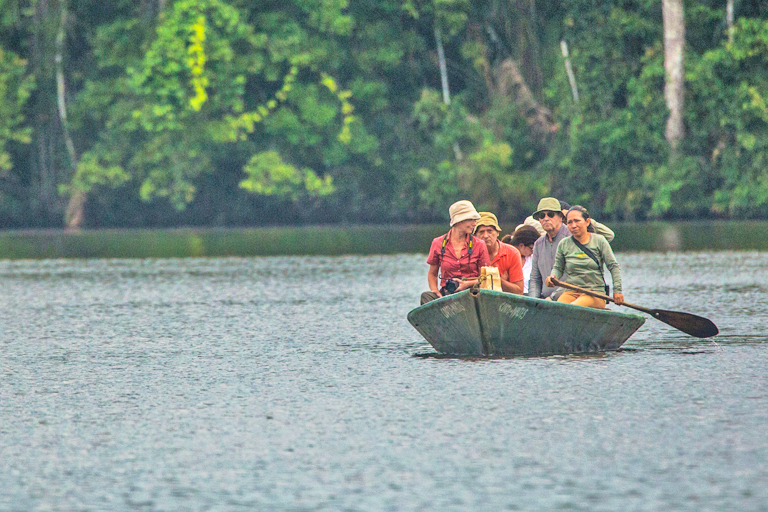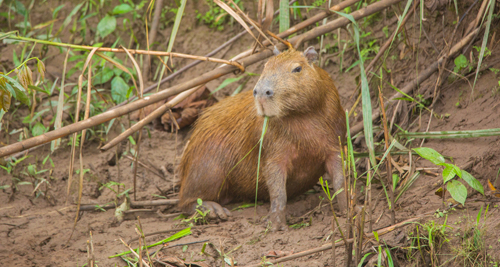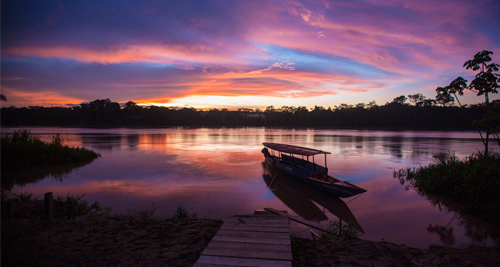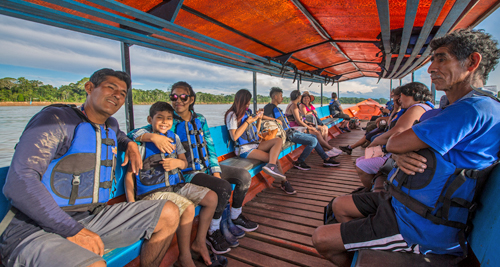
 3 days / 2 nights
3 days / 2 nights  From US$ 249,00 per person
From US$ 249,00 per person  Difficulty:
Low
Difficulty:
Low  Max. Altitude:
200 m
Max. Altitude:
200 m  8 km
8 km Embark on a journey to the breathtaking Tambopata, a natural paradise located in the heart of the Peruvian Amazon. Our Tambopata 3-day tour is the perfect opportunity to discover the wonders of this unique ecosystem, with its diverse wildlife, lush vegetation, and stunning landscapes.

Tambopata's untamed wilderness invites nature lovers to revel in its vibrant biodiversity, immersing themselves in the captivating sights.

Enjoying overnights on this tour, you will have the opportunity to enjoy wildlife during the day and also be able to enjoy nature at night and see caimans and other nocturnal animals.

Enjoy a boat ride to get to the lodges in the jungle. During the tour, enjoy unique landscapes and lots of wildlife.
Welcome to Puerto Maldonado
Lodge - Sandoval lake - Lodge
Canopy - Puerto Capitania - Puerto Maldonado

Day 1: Puerto Maldonado – Jungle lodge – Caiman Area
Once you arrived in Peru’s biodiversity capital, (Puerto Maldonado), your team will welcome you at the airport or bus station. Then our transfer will start to show you around the city.
After meeting your team you will go to Puerto Capitalia in order to board a motorized riverboat. Then we will navigate on the Madre de Dios river for 1 hour approximately before arriving at your jungle lodge. There you will be welcomed by our adventure staff and get an introduction to our 20-hectare lands. Then our guide will organize the bungalow for your stay.
If you want, you can choose what type of room would you like to use, just let know us by e-mail if you are a family or couple for a better room organization.
While you discover your lodge or if you prefer, take some time to rest, our chef will be preparing your amazing lunch with local productos.
Then all the group will gather to enjoy it together and start talking about the plan for that afternoon and night.
After lunch, our tour guide will take you to on a hike for approximately 1 to 2 hours. You will see tropical fruits, native plants and trees and learn about the jungle. Then your guide will take you to some lookouts, where you can enjoy the toucans and other birds. Afterward, you will go back to your lodge to rest Approximately 7:00 p.m. your group will leave with a guide on a Caiman Safari. As you cruise on the river you will be able to see the wild nightlife by the riverbank.
At the end of the boat ride we will return for your dinner and talk about plans for next day.
Day 2: Jungle lodge – Sandoval Lake – and jungle hike
You will wake around 6:00 am to the sound of birds. Then we will go to enjoy our breakfast and get last details from our guide for the day. After breakfast you will go by boat for 20 minutes to the landing at Sandoval Lake. Then you have a hike of 3 km to the main stop of Tambopata National Reserve (Sandoval Lake). Here you will have the chance to see an exciting diversity of animals – snakes, howlers and hundreds of birds. Once we get to Sandoval Lake we will get into a smaller rowing boat and, with your guide and staff, you’ll go in search of the giant otters. Also waiting for you to discover are caiman, piranhas, snakes, tapirs, turtles, cormorants, herons and of course lots of birds.
Then you will go back to your lodge where you can enjoy spectacular views of the sunset panoramas of the Jungle.
If you still have energy after dark, why not go on an exciting adventure with your guide to discover nocturnal wildlife? Discover fascinating creatures like insects, capybaras and other nocturnal animals as you learn about their behavior and habitats under the stars. Then you end the day with a delicious dinner.
Day 3: Jungle activities – Canopy – Puerto Maldonado
Upon waking up, you will have the opportunity to relish a delightful breakfast and prepare yourself for a stroll in the vicinity of your lodge, while relishing breathtaking panoramas from lookout points, also known as canopy. You may get lucky and have a glimpse of an assortment of creatures, such as snakes, parrots, monkeys, and other wildlife. Later, you will make arrangements to embark on a boat ride, and your transport will convey you back to Puerto Maldonado. Then you will be taken to your bus station or the airport for your departure,
make sure you don’t forget anything in the lodge or at the travel office.
Not Included
What you should bring
Where is Tambopata Amazon Reserve located?
The Tambopata National Reserve is located in southeastern Peru,(1.5 hours fly from Lima or 1 hours from Cusco) in the departments of Madre de Dios. It covers an area of approximately 1,478,942 acres (598,140 hectares) of protected tropical forest and is situated near the border with Bolivia. The reserve is known for its incredible biodiversity and is home to many species of plants and animals, including macaws, monkeys, jaguars, and giant otters. It is a popular destination for ecotourism and scientific research.
What is the climate like in Tambopata Amazon Reserve?
The climate in Tambopata Amazon Reserve is tropical, with high humidity and heavy rainfall throughout the year. The region experiences a rainy season from November to April, with the heaviest rains falling between December and March. During this time, the rivers and streams in the reserve can swell significantly, making some areas inaccessible. The dry season, which lasts from May to October, is generally characterized by clear skies, cooler temperatures, and lower humidity. However, even during the dry season, it can still rain on occasion. Temperatures in the reserve generally range between 20 and 30 degrees Celsius (68 to 86 degrees Fahrenheit), with cooler temperatures at higher elevations.
What kind of animals can be found in Tambopata Amazon Reserve?
Tambopata Amazon Reserve is one of the most biodiverse areas on the planet, with an incredibly rich variety of plant and animal life. Some of the animals that can be found in the reserve include:
Jaguar
Giant river otter
Capybara
Anaconda
Howler monkey
Spider monkey
Tamarin monkey
Macaws (such as the scarlet macaw)
Toucans
Tapir
Puma
Caiman
Sloths
Armadillos
These are just a few examples of the many species that inhabit the reserve. In addition to the larger animals, there are also thousands of species of insects, birds, and reptiles, as well as many species of fish and amphibians found in the rivers and streams. The diversity of wildlife in the reserve makes it a popular destination for nature lovers and wildlife enthusiasts.
What kind of plants can be found in Tambopata Amazon Reserve?
Tambopata Amazon Reserve is home to an incredibly diverse array of plant species, with estimates of over 10,000 species in the area. The vegetation in the reserve includes various types of forest, including lowland rainforest, floodplain forest, and cloud forest at higher elevations. Some of the plant species found in the reserve include:
Brazil nut tree
Ceiba tree (also known as kapok tree)
Mahogany tree
Palm trees (various species)
Rubber tree
Cacao tree
Medicinal plants (such as ayahuasca, cat’s claw, and dragon’s blood)
Orchids (over 1,200 species have been recorded in the area)
Heliconias
Bromeliads
Ferns
What is the Tambopata River?
The Tambopata River is a river that runs through the Tambopata National Reserve in southeastern Peru. The river begins in the high Andes mountains and flows eastward through the reserve before joining the Madre de Dios River. The Tambopata River is approximately 402 kilometers (250 miles) long and is one of the main tributaries of the Madre de Dios River, which in turn is a tributary of the Amazon River.
What kind of activities can visitors do in Tambopata Amazon Reserve?
There are many activities that visitors can do in Tambopata Amazon Reserve, All depend on the time you have and the tour you chose:
Wildlife watching: The reserve is home to a vast array of plant and animal life, and visitors can see many species of birds, monkeys, giant river otters, and other animals.
Jungle hikes: There are many trails in the reserve that visitors can explore on foot, ranging from short walks to longer treks lasting several days.
Canoe and boat tours: The Tambopata River and other waterways in the reserve provide an opportunity to explore the rainforest from a different perspective, with canoe and boat tours taking visitors to areas where they can spot wildlife and learn about the ecosystem.
Birdwatching: The reserve is a haven for birdwatchers, with over 600 species of birds recorded in the area, including macaws, toucans, and hummingbirds.
Night walks: Guided night walks provide a unique opportunity to see nocturnal animals such as frogs, owls, and night monkeys.
Ecotourism projects: Visitors can learn about conservation efforts and participate in ecotourism projects aimed at supporting sustainable development in the region.
Cultural experiences: The reserve is home to several indigenous communities, and visitors can learn about their way of life and traditional practices.
What is the best time of year to visit Tambopata Amazon Reserve?
The best time to visit Tambopata Amazon Reserve depends on the traveler’s preferences and what they want to see and do in the area. Here is an overview of the weather and wildlife activity during the different seasons:
Dry season (May to October): This is the best time to visit if you prefer drier weather and clearer skies. The temperatures are also cooler and more comfortable during this time. The river levels are lower, which makes it easier to navigate by boat and canoe, and many animals can be seen congregating around water sources. However, wildlife sightings may not be as frequent during the dry season, as animals have access to water from fewer sources.
Wet season (November to April): This is the best time to visit if you want to see the rainforest in full bloom and witness the lush greenery of the forest. The wet season is characterized by heavy rainfall, which can make travel and exploration more challenging. However, this is also the best time to spot migratory birds, and many animals such as reptiles and amphibians are more active during the wet season. The river levels are higher during this time, which provides access to areas that are not accessible during the dry season.
Overall, both seasons offer unique experiences and have their advantages, and the best time to visit depends on your interests and preferences.

Search